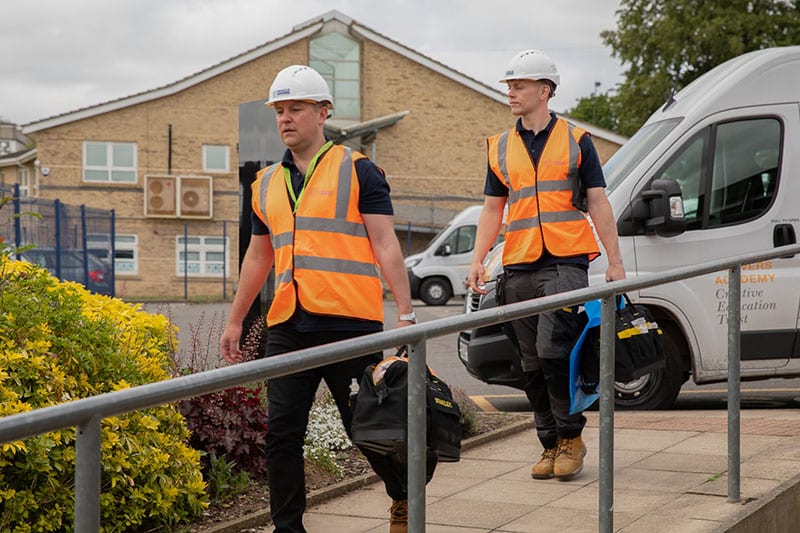What steps should I take if I suspect asbestos is present in my workplace or home?
The very term “asbestos” is, today, widely associated with severe risks to public health. For much of the 20th century, however, this fibrous silicate mineral was hailed as a “wonder material”, due to such qualities as its physical strength, fire resistance, and effectiveness as an insulator.
This helps to explain why the substance was extensively used across both residential and commercial buildings, until it was banned in 1999. Indeed, to this day, there are believed to be as many as 1.5 million buildings up and down the UK that still contain asbestos.
- Here’s some bad news about the prevalence of asbestos in UK homes and workplaces: in the case of any given structure dating to before the year 2000, there is a very strong chance that asbestos-containing materials (ACMs) will be present inside.
- The good news, though, is that ACMs are believed to pose negligible risk to health if they are in good condition and undisturbed.
Nonetheless, if you do come across certain materials in your domestic or commercial building that you suspect to contain asbestos, it is important to know what response is appropriate in this situation. After all, you won’t want to put your own health – or that of the other users or occupants of your building – at avoidable risk.
Below, then, is an explanation of the exact steps to take if you discover suspected asbestos-containing materials at your site.

What should I do immediately if I suspect asbestos?
In the past here at Oracle Solutions, we have written about such topics as where asbestos can be found in a given property, and what ACMs often look like.
You might have read resources like this previously, so you may already have a sense of what products or materials within your commercial or residential building could be especially likely to contain asbestos fibres.
Let’s presume, then, that you’ve spotted something you strongly believe could be asbestos. In such a scenario, we would urge you to:
- Stop any work you may presently be doing on, or near, the material. This will help avoid or minimise any new or ongoing exposure to asbestos fibres.
- Take steps to secure and isolate the area. Sealing off the area and preventing any further access to it until the suspect material has been properly investigated, will enable you to avoid anyone else inhaling potentially dangerous fibres.
- Clearly mark and restrict access to the given space. Communicating with relevant people – such as the building owner, your employer, or anyone else who lives or works in the property – will help ensure everyone reacts on the basis of the same information.
Who do I inform if I suspect asbestos is present?
The exact people you are advised to inform if you suspect asbestos is present at your property, will depend on your own position and the given type of building:
- If it is your workplace where you have discovered suspected asbestos, we would urge you to contact the site manager or other relevant building management personnel.
- If you are a tenant in a residential property, you are advised to reach out to your landlord or housing provider.
- If you are a resident of a domestic building where you have found possible asbestos materials, you may also seek advice from an environmental health officer at your local authority or council.
Why is professional asbestos surveying necessary, and how do I arrange it?
As referenced above, there might be certain visual indicators of materials in a property potentially being asbestos. However, it is crucial to emphasise that only professional testing of a given suspect substance can definitively prove whether it contains asbestos.
You might have heard of “asbestos sampling kits”, which promise to enable you to perform your own “DIY” asbestos testing. But as we have also written about in the past, these kits can come with certain downsides, such as the quality of the included equipment being highly variable, and the results they provide potentially being unreliable.
As this article is focused on how you should respond if you encounter a specific material you believe could be asbestos (as opposed to, for example, if you are concerned about your building’s broader asbestos situation), it is worth us mentioning that we do offer a professional asbestos sampling service.
However, if you have come across at least one item or material in your building that you suspect to be asbestos, you might like to be reassured as to whether there are further examples of such possible ACMs throughout your building (and if so, informed on what to do about it).
This – along with the regulatory factor – is one reason why you might consider having a full asbestos survey undertaken at your building.
So, presuming you decide to go with a professional asbestos surveying service to confirm whether certain materials in your buildings are ACMs, let’s take you through the types of asbestos surveys that exist:
- A management survey is designed to help with the management of ACMs during the normal occupation and use of a building.
- A refurbishment or demolition survey is more intrusive and destructive than a management survey. As its name implies, it is designed to locate and identify all ACMs in the particular building so that they can be removed before structural work – such as refurbishment or demolition – is undertaken at the site.
It will, of course, also be vital to make sure you choose a suitably competent asbestos surveyor. This is another subject that our experts at Oracle Solutions have previously written about in some depth, covering such vital matters as the given surveyor’s expertise, accreditation, regulatory compliance, and their insurance and liability coverage.
You will also want to be sure that the scope of the survey you arrange will be sufficient in light of the potential ACMs in your property that you are concerned about.
What legal obligations do I have regarding asbestos in the UK?
This is a topic that can cause confusion among the owners and managers of residential and commercial buildings. So, to keep things (relatively) simple, we’ll zoom in on the overarching asbestos legislation for Great Britain: the Control of Asbestos Regulations 2012 (CAR 2012).
A fundamental component of CAR 2012 is the “duty to manage” asbestos. If a given individual or organisation has the “duty to manage” asbestos at a given building (for example, because they have clear responsibility for the property’s maintenance or repair), they will have certain responsibilities under this legislation.
Those responsibilities will include, but will not be limited to:
- Assessing whether any ACMs are present – and if so, what their type, location, and condition are
- Presuming materials contain asbestos, unless there is strong evidence of this not being the case
- Making, and keeping up to date, a record or register of the location and condition of the ACMs or presumed ACMs
- Writing an asbestos management plan to manage the risks, followed by putting this plan into action
- Providing information on the location and condition of the ACMs to anyone who may work on or disturb them, including the emergency services.
CAR 2012’s “duty to manage” asbestos is widely perceived as applying only to non-domestic properties, although this isn’t strictly the case. That’s because it does cover the “common parts” (such as entrance halls or corridors) of multi-occupancy domestic premises, such as purpose-built flats.
- If you’re an owner-occupier of a residential property, you won’t be legally responsible for the risks to builders or contractors from asbestos in your building.
- The situation is, though, slightly different if you’re a landlord or another owner of a residential property who isn’t an owner-occupier. As aforementioned, certain communal areas come under the “duty to manage”, but the individual flats or private houses themselves aren’t covered by this duty.
When should asbestos be removed or managed in place?
Even if a particular material or product in your home or workplace is confirmed to be asbestos, it does not automatically follow that the material will need to be removed from your building.
You may, for example, choose to leave a particular ACM in place at your site, and to arrange to monitor the material over time. As part of this, you might opt to have the material “encapsulated” – in other words, effectively “sealed off”, to prevent the dangerous release of loose asbestos fibres from the ACM in the future.
Here are some factors to consider when you are determining whether to remove an ACM from your property, or instead to have it managed in place:
- The risk the given ACM poses. Removal is typically recommended if, for instance, the particular ACM is severely damaged or deteriorated, and/or is in a location that makes future disturbance likely.
- The regulatory situation. Certain types of ACMs are regarded as “licensed” – in other words, they must only be handled by a contractor that holds a Health and Safety Executive (HSE) licence.
- The costs of removal vs monitoring vs encapsulation. Did you know that encapsulating an ACM usually costs around 25% of the cost of removal? This could factor significantly into your thinking when you are deciding on the best course of action.
Here at Oracle Solutions, we would always urge you to consult an asbestos professional when you are attempting to make this decision. They will be able to advise you on the approach that will likely be safest and most cost-effective in the long term.
Where can I find further support and resources regarding asbestos management?
There are various online and offline resources to which you can turn, if you are unsure about any aspect of responding to ACMs in your domestic or commercial property:
- The HSE website, which has an asbestos section
- Advice and guidance on asbestos from your local council, including on its website
- Professional organisations such as the Asbestos Removal Contractors Association (ARCA)
- The comprehensive Learning Centre on the website of Oracle Solutions.
Conclusion
Whether it is your own home or a work premises where you are concerned about a particular material potentially being asbestos, the correct asbestos management will be critically important.
By dealing with the situation immediately but cautiously and leaning on the advice and guidance of professional asbestos consultants, you can help ensure you take the right steps.
Contact Oracle Solutions today to learn more about our asbestos services, and to ask for a free quote.

Written by Jess Scott
Jess Scott has been an all-round asbestos consultant since 1996. That’s nearly 3 decades of asbestos knowledge. He spends his time sharing that knowledge with the team at Oracle and with their clients. Jess's goal is, and always has been, to use my expertise in helping people to comply with the law. This legal compliance ultimately helps to protect everyone from the harmful effects of asbestos. Jess has acted as an asbestos expert witness in legal cases and is involved in many asbestos educational activities throughout the UK.
